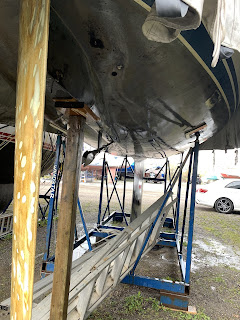The VC-TAR on Windstar’s bottom has stood up for many years. It’s still resilient, and though cracking somewhat, and I decided to tackle stripping the rudder to see what might be required to do the entire bottom at some point.
It is difficult to remove. Good stuff I guess. It is rubbery and clogs grinding discs and sandpaper, and resists even a stiff wire cup brush on an angle grinder. I was finally able to use 1 litre of EZ strip and a sharp scraper to remove most of the material, and whatever remained was quite easy to sand off with 40 then 60 grit and a random orbit sander. The results below. Took about 4 hours total I imagine. You can see at the lower aft corner my previous small epoxy/glass repair, where I had noticed a small hairline crack several years back. The repair was done carefully, is very solid, and the rudder is sound and dry inside and appears never to have had a problem with water ingress.
Later note - as COVID provided some time to smooth and fair a few other parts of windstar's bottom, I found the VC-Tar can indeed be sanded off - it takes patience, many discs, and a means of collecting the considerable dust.
Newly coated with two thick layers of laminating epoxy, and will be faired prior to anti fouling. See further below, it also received a coat of interprotect.
2 thick coats of epoxy and looking gnatty!
Meanwhile, just across the boatyard...
Love your rudder and it will love you back! Don’t, and it will pay you back. The image below was shot after haulout last year - this certainly surprised the owner, whose boat emerged from the lake with the exterior skin of its rudder dangling and the core exposed as you see. He had not collided with anything, the rudder shell it had simply failed. Probably waterlogged, froze, split, etc.
Looking closely you could see evidence of a prior, substandard repair.
Back to Windstar - launch delayed by Covid, I decided to have a go at the bottom and clean it up a bit. Did not remove all the VC-Tar however I skim it with 60 grit and smooth a few small repairs and flaky spots - ready for VC17 bottom paint. Also sanded some areas clean and epoxied some hasty fairing I had done in the past. Photos for posterity, to document past touch-up repairs and interprotect. She rarely gets any blisters (1-3 every third season maybe?) but you can see them all in the photos below.
Sanded fair and all touch-up areas coated with interprotect 2000. The rudder was given a coat as well even though it had already been well entombed in epoxy. Obviously the interprotect was applied over a needlessly large area. This type of work requires a good dust collection setup.
















































